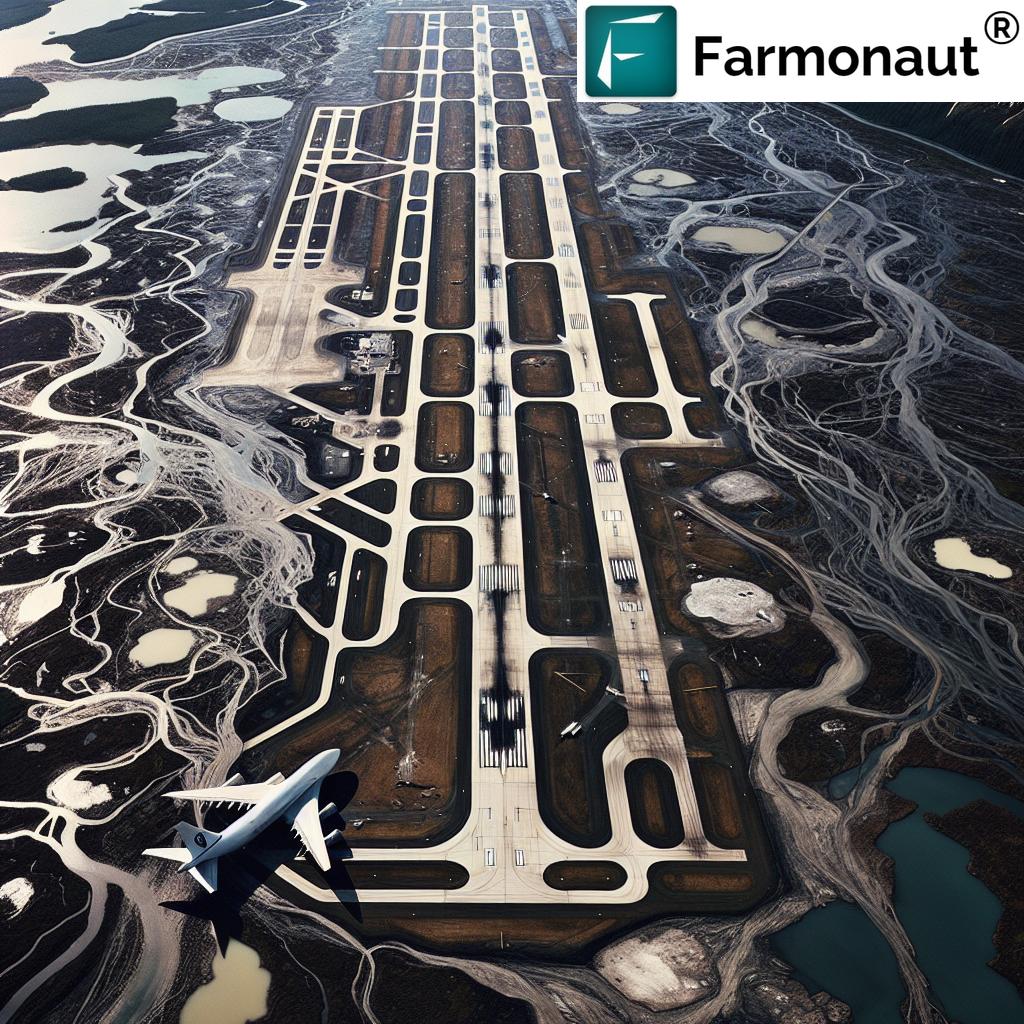Anchorage International Airport: Tackling Unique Maintenance Challenges in Alaska’s Harsh Environment
“Anchorage International Airport handles over 2.5 million tons of cargo annually, making it one of North America’s busiest cargo hubs.”
When it comes to airport maintenance, few locations present as many unique challenges as Alaska. At the heart of this frozen frontier lies Ted Stevens Anchorage International Airport (TSAIA), a crucial hub for both passenger and cargo traffic in North America. In this comprehensive exploration, we’ll delve into the intricate world of Alaska airport maintenance, focusing on the extraordinary measures taken to keep TSAIA operational in the face of harsh environmental conditions.
The Alaskan Challenge: A Unique Environment for Airport Infrastructure
Alaska’s climate and geography create a perfect storm of challenges for airport maintenance. From permafrost to extreme temperature fluctuations, every aspect of airport operations must be carefully considered and adapted to suit this unforgiving landscape.
- Wet soils and permafrost
- Extreme temperature variations
- Heavy snowfall and ice accumulation
- Intense cargo traffic
These factors combine to create a maintenance environment unlike any other in the world. Let’s explore how the Alaska Department of Transportation and Public Facilities (DOT) tackles these challenges head-on.
Ted Stevens Anchorage International Airport: A Marvel of Engineering
TSAIA is not just any airport; it’s a testament to human ingenuity in the face of natural adversity. Covering approximately 220 acres of runway and 341 acres of taxiway, this sprawling facility serves as a critical link between North America and Asia for both passenger and cargo operations.

Shannon McCarthy, the DOT’s Communication Director, emphasizes the unique challenges faced by TSAIA: “Our airport infrastructure must withstand not only the weight of massive cargo planes but also the constant assault from Alaska’s harsh climate. It’s a delicate balance that requires ongoing vigilance and innovative solutions.”
Drainage Systems: The Unsung Heroes of Runway Maintenance
One of the most critical components in maintaining TSAIA’s runways is its sophisticated drainage system. This intricate network of pipes and channels plays a vital role in preventing water pooling, which can lead to severe asphalt damage over time.
- Prevents water accumulation on runways and taxiways
- Reduces the risk of ice formation during colder months
- Helps maintain the structural integrity of the pavement
The drainage system at TSAIA is a marvel of engineering, designed to handle the unique challenges posed by Alaska’s wet soils and permafrost. By efficiently channeling water away from critical areas, it significantly reduces the risk of pavement deterioration and ensures safer operations for aircraft.
Elevated Land: A Strategic Approach to Ground Settling
Another innovative solution employed at TSAIA is the use of elevated land. This strategic design choice helps mitigate the risks associated with ground settling, a common issue in areas with permafrost.
- Reduces the impact of permafrost thawing
- Minimizes the risk of runway sinking
- Improves overall drainage efficiency
By elevating the land beneath runways and taxiways, TSAIA’s engineers have created a more stable foundation that’s better equipped to handle the unique geological challenges of the region.
The Weight of Success: Managing Heavy Cargo Traffic
As the second-busiest cargo airport in North America and the fourth busiest in the world, TSAIA faces immense pressure from the sheer weight of aircraft it handles daily. Cargo jets weighing between 100,000 to one million pounds frequently use the facility, causing significant wear and tear on the runways.

Tim Lufkin, from airport operations, explains: “The weight of these massive cargo planes is our primary concern. Their frequent landings and takeoffs cause inevitable wear, leading to cracks in the pavement. It’s a constant battle to keep up with the damage while ensuring the airport remains operational.”
Cracking the Code: Innovative Pavement Repair Techniques
Dealing with pavement cracks is a never-ending task at TSAIA. The maintenance team employs a range of innovative techniques to address this issue:
- Annual crack sealing programs
- Advanced asphalt patching methods
- Continuous monitoring and assessment
Each summer, the maintenance team meticulously applies sealant to every visible crack and performs asphalt patching to maintain the integrity of the runways. This proactive approach helps prevent moisture infiltration, which can exacerbate pavement damage.
Rutting: A Unique Challenge for Heavy Traffic Areas
Rutting, or the formation of surface depressions in the wheel paths of aircraft, is another significant concern at TSAIA. These depressions can severely affect aircraft safety if left unaddressed.
Lufkin humorously describes his method for assessing when repairs are necessary: “If a rut can spill my coffee when filled to three-quarters, it’s time for intervention.” This practical approach underscores the importance of regular, hands-on inspection in maintaining airport safety.
The Repair Process: Milling and Replacing
When rutting becomes severe enough to warrant repair, the maintenance team follows a specific process:
- Milling out the damaged areas
- Preparing the surface for new asphalt
- Applying a fresh asphalt mix
- Compacting and finishing the repaired section
This process ensures that the repaired areas seamlessly integrate with the existing runway surface, maintaining a smooth and safe operating environment for aircraft.
Environmental Factors: The Constant Battle Against Nature
“Alaska’s airports employ specialized techniques to manage over 200 freeze-thaw cycles per year, preventing runway damage and ensuring safety.”
Alaska’s harsh climate presents a unique set of challenges for airport maintenance. The frequent freeze-thaw cycles can wreak havoc on pavement, causing rapid deterioration if not properly managed.
- Extreme temperature fluctuations
- Heavy snowfall and ice accumulation
- High winds and storm events
To combat these environmental factors, TSAIA employs a range of specialized techniques and technologies. From advanced de-icing systems to specially formulated cold-weather asphalt mixes, every aspect of maintenance is tailored to Alaska’s unique climate.
Innovative Technologies in Airport Maintenance
As we continue to face the challenges of maintaining Anchorage International Airport, innovative technologies play an increasingly important role. While our focus remains on traditional infrastructure solutions, we recognize the potential of cutting-edge tools to enhance our maintenance efforts.
For instance, satellite-based monitoring systems, like those offered by companies such as Farmonaut, could potentially be adapted for airport use. While primarily designed for agricultural applications, these technologies demonstrate the power of remote sensing in monitoring large areas for changes and potential issues.
Imagine being able to detect subtle changes in runway surfaces or identify potential drainage issues before they become visible to the naked eye. While not currently implemented at TSAIA, such technologies represent the future of proactive airport maintenance.
Balancing Act: Efficiency and Safety in Airport Operations
Maintaining the delicate balance between operational efficiency and safety is a constant challenge at TSAIA. With daily traffic nearing 15,000 passengers and constant jet operations, the pressure to keep the airport running smoothly is immense.
Key factors in maintaining this balance include:
- Proactive maintenance schedules
- Rapid response to emerging issues
- Continuous staff training and development
- Investment in cutting-edge maintenance equipment
By focusing on these areas, TSAIA ensures that it can meet the demands of its busy schedule while never compromising on safety.
The Future of Airport Maintenance in Alaska
As we look to the future, it’s clear that the challenges facing Anchorage International Airport and other Alaskan airports will only grow more complex. Climate change, increasing air traffic, and evolving aircraft technologies will all play a role in shaping the future of airport maintenance.
Some key areas of focus for the future include:
- Adoption of AI and machine learning for predictive maintenance
- Development of more durable and weather-resistant pavement materials
- Implementation of advanced sensor technologies for real-time monitoring
- Increased use of renewable energy sources to power airport operations
By staying at the forefront of these technological advancements, TSAIA and other Alaskan airports can continue to provide safe and efficient service in the face of ever-growing challenges.
Anchorage International Airport Maintenance Challenges and Solutions
| Maintenance Challenge | Cause | Impact | Solution |
|---|---|---|---|
| Runway Drainage Issues | Wet soils, permafrost, heavy precipitation | Water pooling, potential for ice formation | Sophisticated underground drainage system |
| Pavement Cracking | Heavy aircraft weight, freeze-thaw cycles | Compromised runway integrity, safety risks | Annual crack sealing, advanced asphalt patching |
| Rutting Problems | Repetitive heavy aircraft traffic | Uneven runway surface, potential safety hazard | Milling and replacing affected areas |
| Permafrost-related Concerns | Alaska’s unique geology | Ground settling, potential for runway sinking | Elevated land construction, continuous monitoring |
| Moisture-induced Damage | High precipitation, humidity | Accelerated pavement deterioration | Waterproof sealants, improved drainage systems |
The Role of Technology in Modern Airport Maintenance
As we continue to push the boundaries of what’s possible in airport maintenance, technology plays an increasingly crucial role. While our focus at TSAIA remains on traditional infrastructure solutions, we’re always exploring new ways to enhance our maintenance efforts.
For example, advanced monitoring systems, similar to those used in precision agriculture, could potentially be adapted for airport use. These technologies demonstrate the power of data-driven decision-making in managing large areas efficiently.
Consider the potential applications:
- Real-time monitoring of runway surface conditions
- Predictive maintenance based on data analytics
- Automated detection of potential drainage issues
- Enhanced weather forecasting for more efficient operations
While these specific technologies are not currently implemented at TSAIA, they represent the kind of innovative thinking that drives our ongoing efforts to improve airport maintenance and safety.
Collaboration and Knowledge Sharing in Airport Maintenance
One of the key strengths in addressing the unique challenges of Alaska airport maintenance is the spirit of collaboration and knowledge sharing within the industry. TSAIA actively participates in various forums and conferences, exchanging best practices and innovative solutions with airports facing similar challenges around the world.
This collaborative approach allows us to:
- Learn from the experiences of other cold-climate airports
- Share our own innovations and success stories
- Stay updated on the latest technological advancements
- Contribute to the global conversation on airport safety and efficiency
By fostering these connections, we ensure that TSAIA remains at the forefront of airport maintenance practices, continually improving our ability to serve the needs of Alaska and the global aviation community.
The Economic Impact of Efficient Airport Maintenance
The importance of maintaining TSAIA goes beyond just ensuring safe operations. As a major cargo hub, the airport plays a crucial role in Alaska’s economy and serves as a vital link in global supply chains.
Efficient maintenance practices contribute to:
- Reduced downtime and flight delays
- Lower operational costs for airlines
- Increased cargo handling capacity
- Enhanced competitiveness in the global aviation market
By investing in innovative maintenance solutions and proactive strategies, TSAIA not only ensures safety but also strengthens its position as a key player in international air transport.
Environmental Stewardship in Airport Maintenance
As stewards of Alaska’s unique environment, TSAIA is committed to implementing maintenance practices that minimize ecological impact. This commitment extends to every aspect of our operations, from the materials we use to the technologies we employ.
Some of our environmentally conscious initiatives include:
- Use of eco-friendly de-icing fluids
- Implementation of energy-efficient lighting systems
- Recycling of construction materials during runway repairs
- Exploration of renewable energy sources for airport operations
By prioritizing environmental stewardship alongside safety and efficiency, we ensure that TSAIA remains a responsible member of the Alaskan community and a leader in sustainable airport operations.
Conclusion: Rising to the Challenge
Maintaining Anchorage International Airport in the face of Alaska’s harsh environment is a testament to human ingenuity and perseverance. Through innovative solutions, dedicated staff, and a commitment to safety and efficiency, TSAIA continues to serve as a crucial hub for both passenger and cargo traffic.
As we look to the future, we remain committed to:
- Embracing new technologies and maintenance techniques
- Adapting to the challenges posed by climate change
- Enhancing our environmental stewardship
- Continuing to serve as a vital link in global air transportation
The unique challenges faced by Anchorage International Airport serve as a reminder of the critical role that innovative maintenance practices play in keeping our skies safe and our global connections strong. As we continue to tackle these challenges head-on, we pave the way for a future where air travel remains safe, efficient, and accessible, even in the most demanding environments.
FAQ Section
Q: How does Anchorage International Airport handle snow removal?
A: TSAIA employs a dedicated snow removal team equipped with specialized machinery designed for rapid clearing of runways and taxiways. The airport’s snow removal plan is regularly updated to ensure minimal disruption to flight operations during heavy snowfall events.
Q: What measures are in place to prevent wildlife interference with aircraft?
A: TSAIA has a comprehensive wildlife management program that includes habitat modification, deterrent techniques, and regular patrols. The airport works closely with wildlife biologists to minimize the risk of animal encounters on runways and taxiways.
Q: How often are runways inspected at Anchorage International Airport?
A: Runways at TSAIA are inspected multiple times daily, with more comprehensive assessments conducted weekly and seasonally. These inspections cover everything from surface conditions to lighting systems and navigational aids.
Q: What technologies are used to monitor runway conditions in real-time?
A: TSAIA utilizes a combination of weather sensors, friction testing equipment, and visual inspections to monitor runway conditions. Advanced software systems integrate this data to provide real-time information to air traffic controllers and maintenance teams.
Q: How does the airport manage the environmental impact of de-icing operations?
A: The airport employs a sophisticated de-icing fluid recovery system that collects and processes used fluids to minimize environmental impact. Additionally, TSAIA is continually exploring more environmentally friendly de-icing alternatives.
Earn With Farmonaut: Affiliate Program
Earn 20% recurring commission with Farmonaut’s affiliate program by sharing your promo code and helping farmers save 10%. Onboard 10 Elite farmers monthly to earn a minimum of $148,000 annually—start now and grow your income!
For more information on Farmonaut’s API services, visit our API page or check out our API Developer Docs.
















